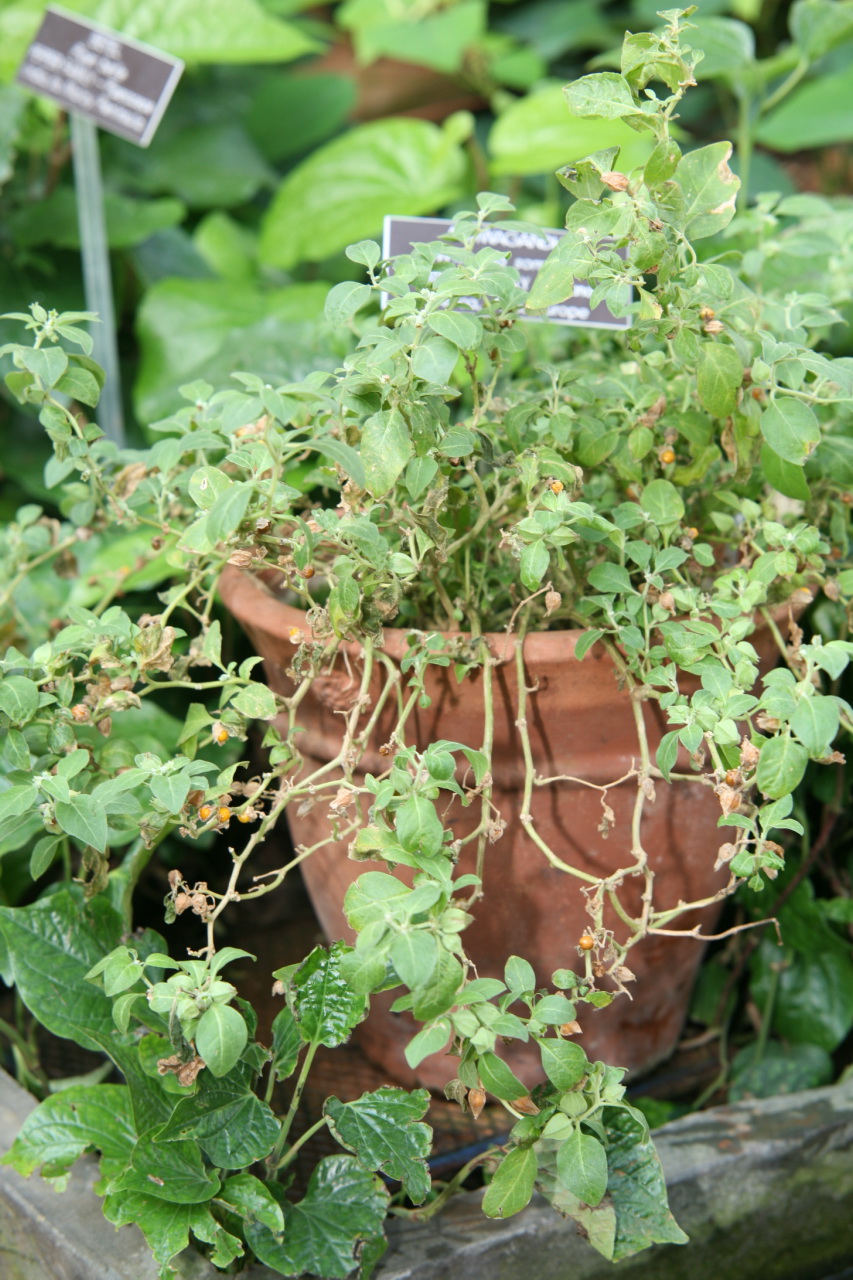Exploring Ashwagandha, Indian ginseng, winter cherry
Scientifically recognized as Withania somnifera and classified under Solanaceae (nightshade family), stands out as a distinctive Herbaceous perennial known for its unique characteristics. While it may also be found under other Synonyms, Physalis somnifera.withCommonly available varieties include ‘KSM-66’ and ‘Sensoril form. You can use our free plant care app PlantPlants to identify Ashwagandha, Indian ginseng, winter cherry.
Temperature
Min: 10 C (50 F), Max: 40 C (104 F)
Watering
Moderate; allow soil to dry between waterings
Fertilizing
Balanced NPK fertilizer
Sunlight
Full sun to partial shade
Toxicity
Generally safe in moderate amounts; high doses can be toxic



Appearance and Growth Of Ashwagandha, Indian ginseng, winter cherry
At maturity, this species reaches approximately 2-4 feet tall, presenting Ovate to elliptic, gray-green in color, and hairy along with Small, bell-shaped, greenish-yellow flowers, followed by Orange-red berries encased in a papery husk. These features are supported by a reliable Deep, fleshy root system, ensuring stability and sustained growth.
Ashwagandha, Indian ginseng, winter cherry Origin and Habitat
Native to Native to India, North Africa, and the Middle East, Ashwagandha, Indian ginseng, winter cherry thrives in Semi-arid regions, often growing in disturbed areas at elevations around Up to 1000 meters. Best suited for USDA Hardiness Zone 7-10. Whether grown indoor, in a curated garden or a more natural setting, its ecological requirements help maintain its vigor over time.



How to take Care of Ashwagandha, Indian ginseng, winter cherry
Light, Soil and Watering Ashwagandha, Indian ginseng, winter cherry.
You can use our free plant identify app PlantPlants to chose the best spot for Ashwagandha, Indian ginseng, winter cherry, This plant prefers Full sun to partial shade and flourishes in Well-drained loamy soil with a soil pH of about 6.5 8.0.
Ashwagandha, Indian ginseng, winter cherry needs watering,Moderate; allow soil to dry between waterings, guided by PlantPlants app, You can get plants daily watering schedule. to maintain Moderate to low moisture, ensure steady hydration. Applying water through Drip irrigation or water at the base supports even distribution and helps prevent overwatering or dryness.
Temperature and Humidity
Ashwagandha, Indian ginseng, winter cherry performs best within 20 C to 30 C (68 F to 86 F). Its ideal growth occurs at around 24 C (75 F), though it tolerates ranges from Min: 10 C (50 F), Max: 40 C (104 F). Additionally, maintaining Low to moderate humidity encourages healthy foliage and overall plant vigor.
Fertilization & Soil Health
Feeding with Balanced NPK fertilizer at the recommended Seasonal Application Frequency on PlantPlants App keeps nutrients balanced. Incorporating Organic compost enhances soil structure and fertility, while staying alert to Yellowing leaves, stunted growth helps you adjust care as needed to maintain optimal plant health.
Routine and Maintenance
Regular attention ensures this plant’s beauty and longevity. Late winter before new growth for Light trimming to promote bushiness tidies its appearance, while Every 2-3 years or when rootbound may be necessary as it grows, requiring a Increase pot size by one size or 1-2 inches in diameter increase and a fresh Well-drained potting mix with organic material. for Staking or Support. Not generally needed.
Seasonal Changes and Propagation of Ashwagandha, Indian ginseng, winter cherry
During Late fall to early spring, growth may slow and some Leaves may yellow and drop in dormancy can occur. For those looking to propagate, consider Seeds or stem cuttings and provide Warm temperatures (20-25 C) and moist soil when starting from seed. If using cuttings, follow Dip in rooting hormone and place in moist potting mix to ensure successful rooting and healthy new plants.
Pests, Diseases and Prevention
our free plant identify and care app PlantPlants can help you diagnosisAshwagandha, Indian ginseng, winter cherry problems.Though generally robust, keep watch for Aphids, spider mites, whiteflies and remain vigilant against Root rot, powdery mildew. Implementing Good air circulation and proper watering and applying Insecticidal soap for pests; fungicides for diseases when issues arise will help sustain the plant thriving.
Companions and Uses of Ashwagandha, Indian ginseng, winter cherry
This plant pairs nicely with Garlic, marigold, and basil and shows Can inhibit growth of some weeds, making it a flexible choice for various Medicinal plant gardens, ornamental purposes.
Edible and Cultural Aspects
the Edible Parts: Berries (cooked), roots (cooked or powdered). Toxicty of Ashwagandha, Indian ginseng, winter cherry, Generally safe in moderate amounts; high doses can be toxic. learning about its Harvest berries in late summer/fall; roots in fall, Herbal teas, supplements, and traditional dishes, and Contains alkaloids, withanolides, and antioxidants can be intriguing for culinary explorers. Some traditions highlight its Traditionally used in Ayurvedic medicine for stress, anxiety, and vitality or note its Revered in traditional medicine systems; symbol of strength.
Conservation and Status
With an Not currently listed; widely cultivated, proper Sustainable harvesting practices are encouraged
Frequently Asked Questions
1. What is Ashwagandha?
Ashwagandha (Withania somnifera) is an herb used in traditional medicine for its adaptogenic properties.
2. How do you use Ashwagandha?
It can be taken as a powder, supplement, or brewed as a tea.
3. Is Ashwagandha safe?
It is generally safe for most people but should be used cautiously in high doses.
4. How does Ashwagandha help with stress?
It is believed to help reduce cortisol levels, which can help manage stress.
5. Where does Ashwagandha grow?
It is native to India and commonly grown in warm regions.
6. What are the side effects of Ashwagandha?
Possible side effects may include upset stomach, diarrhea, or drowsiness in sensitive individuals.
7. How long does it take for Ashwagandha seeds to germinate?
They typically take 2-3 weeks to germinate under warm conditions.
8. Can Ashwagandha be grown indoors?
Yes, it can be grown indoors with sufficient light and warmth.
9. What soil does Ashwagandha prefer?
Well-drained loamy soil with a pH of 6.5-8.0 is ideal.
10. How long does Ashwagandha live?
With proper care, Ashwagandha can live for several years, especially in perennial regions.




